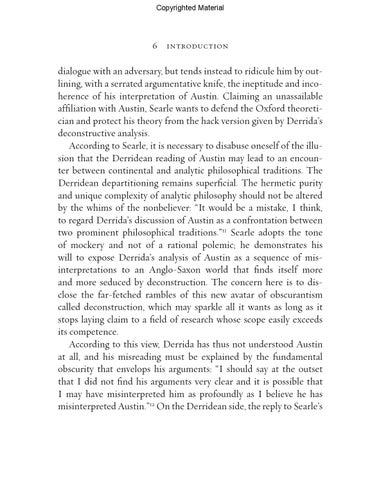Copyrighted Material
6
introduction
dialogue with an adversary, but tends instead to ridicule him by outlining, with a serrated argumentative knife, the ineptitude and incoherence of his interpretation of Austin. Claiming an unassailable affiliation with Austin, Searle wants to defend the Oxford theoretician and protect his theory from the hack version given by Derrida’s deconstructive analysis. According to Searle, it is necessary to disabuse oneself of the illusion that the Derridean reading of Austin may lead to an encounter between continental and analytic philosophical traditions. The Derridean departitioning remains superficial. The hermetic purity and unique complexity of analytic philosophy should not be altered by the whims of the nonbeliever: “It would be a mistake, I think, to regard Derrida’s discussion of Austin as a confrontation between two prominent philosophical traditions.”11 Searle adopts the tone of mockery and not of a rational polemic; he demonstrates his will to expose Derrida’s analysis of Austin as a sequence of misinterpretations to an Anglo-Saxon world that finds itself more and more seduced by deconstruction. The concern here is to disclose the far-fetched rambles of this new avatar of obscurantism called deconstruction, which may sparkle all it wants as long as it stops laying claim to a field of research whose scope easily exceeds its competence. According to this view, Derrida has thus not understood Austin at all, and his misreading must be explained by the fundamental obscurity that envelops his arguments: “I should say at the outset that I did not find his arguments very clear and it is possible that I may have misinterpreted him as profoundly as I believe he has misinterpreted Austin.”12 On the Derridean side, the reply to Searle’s
